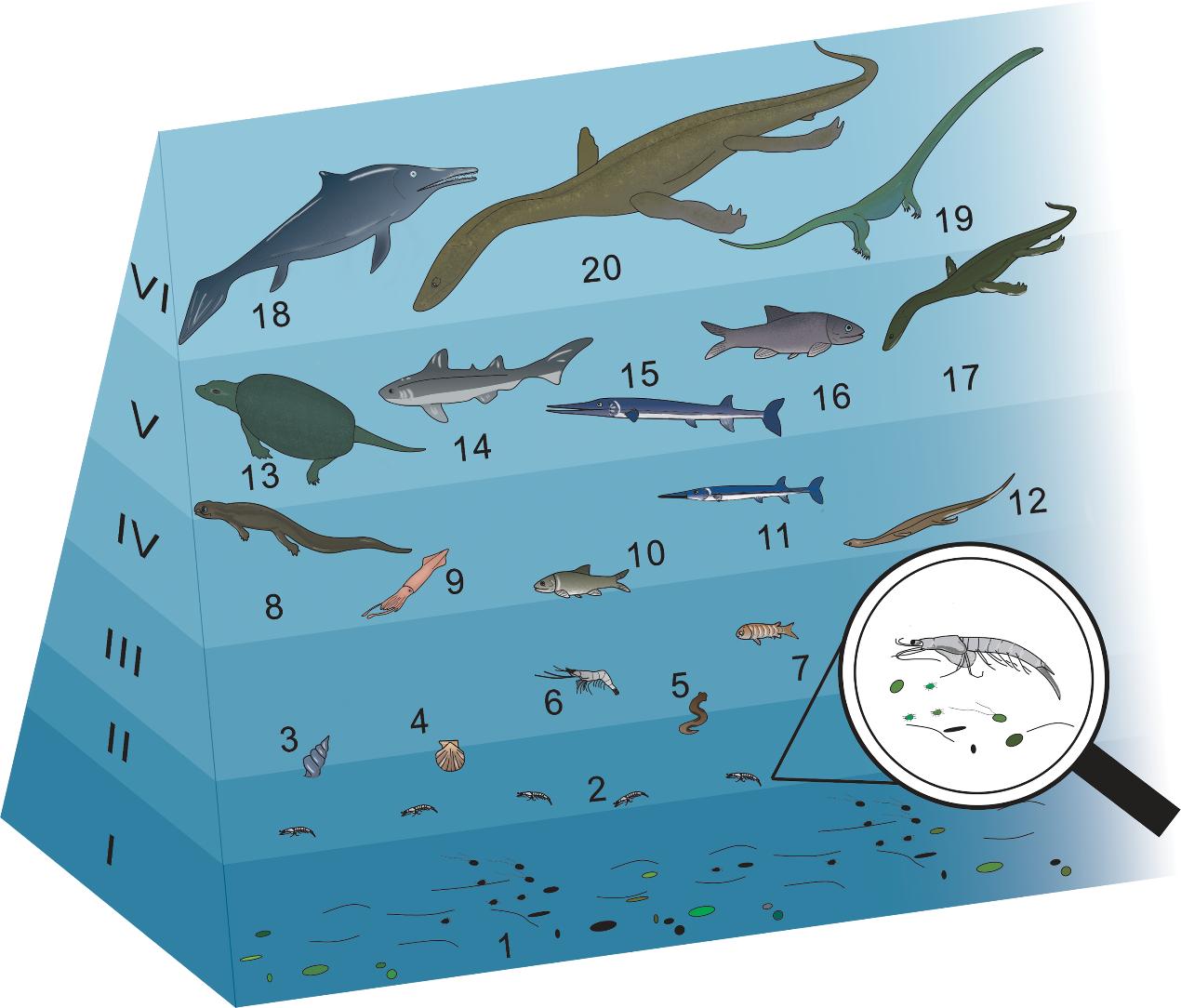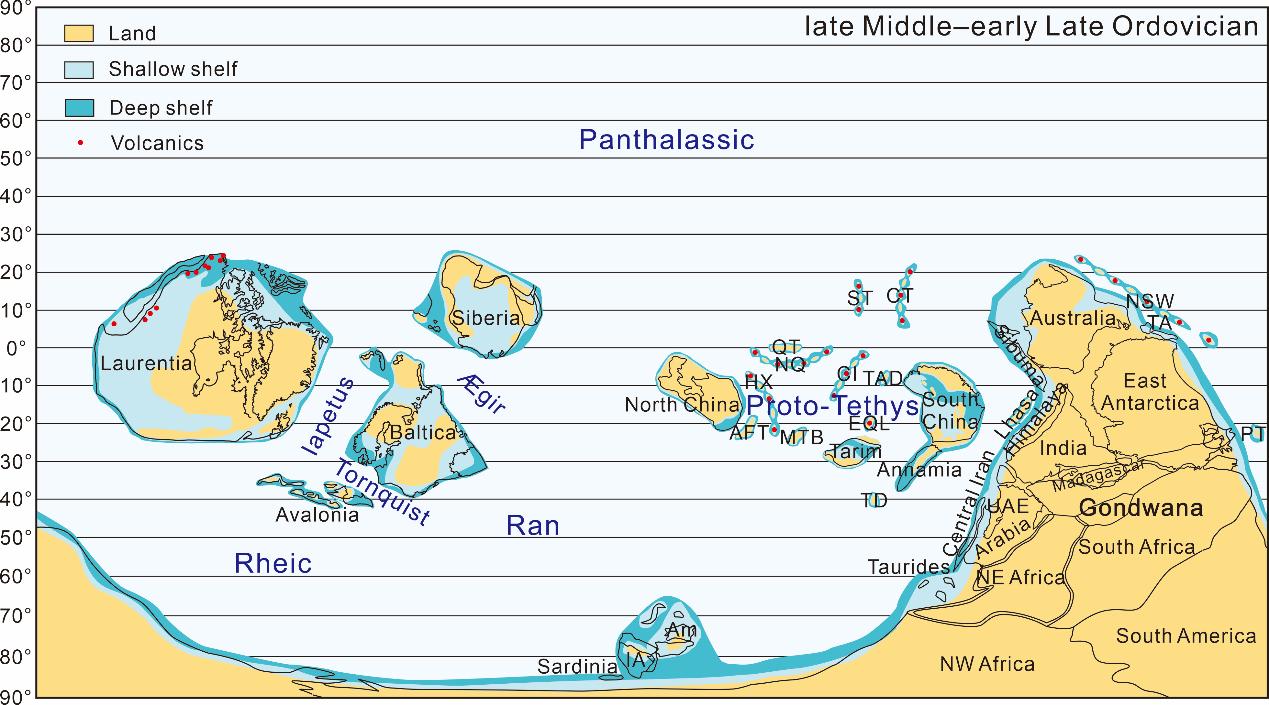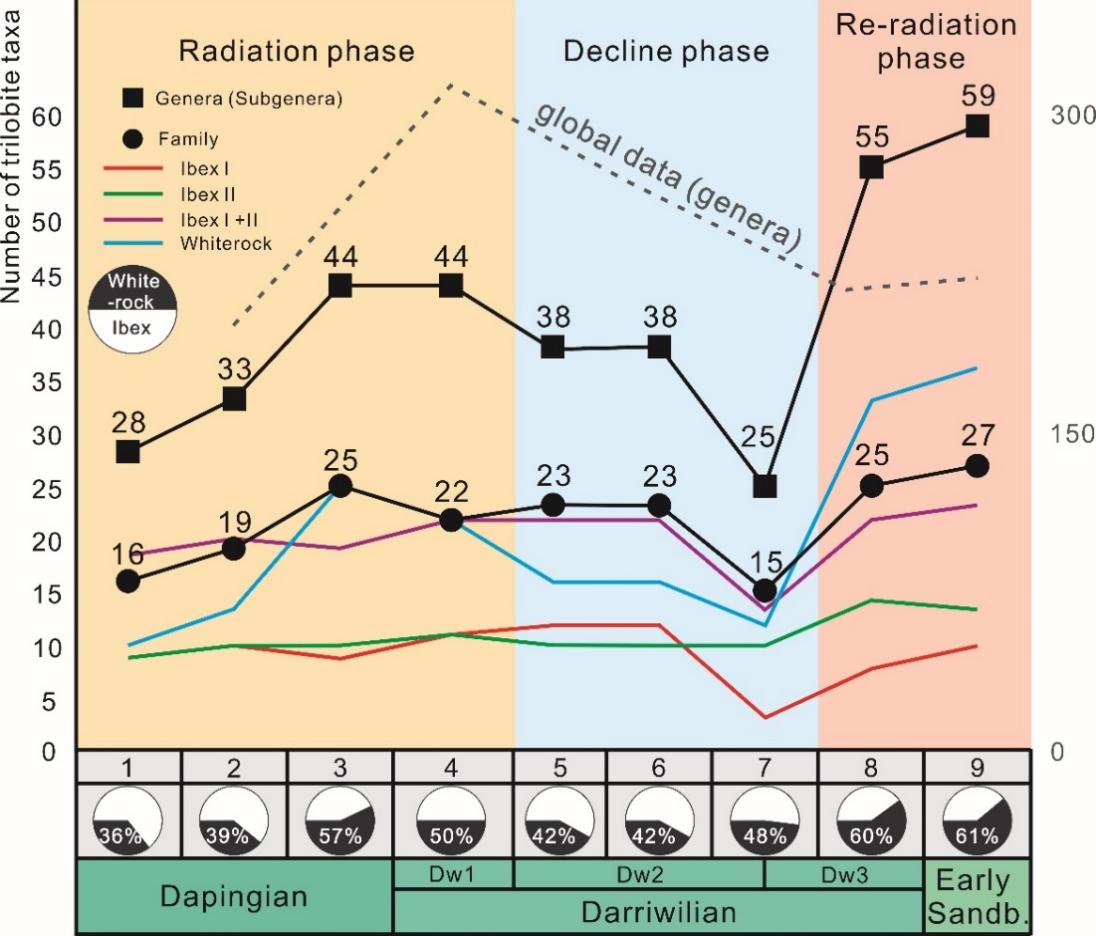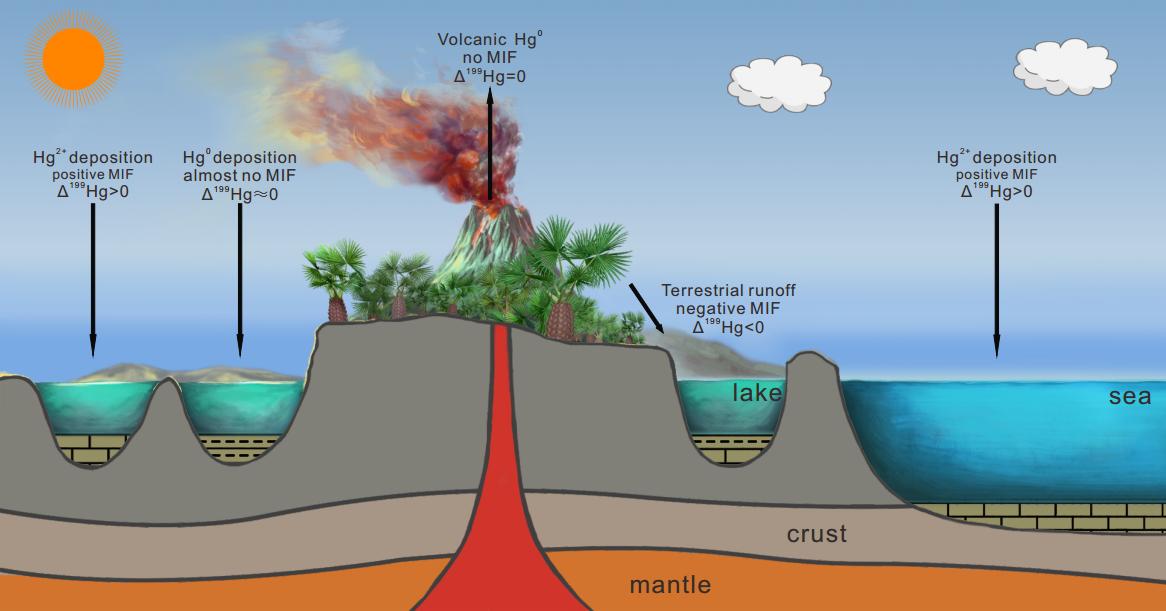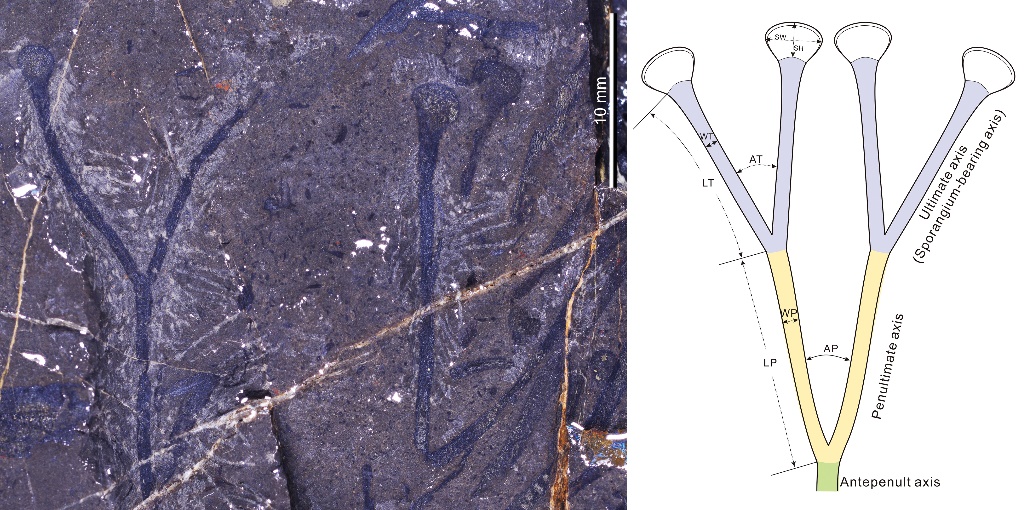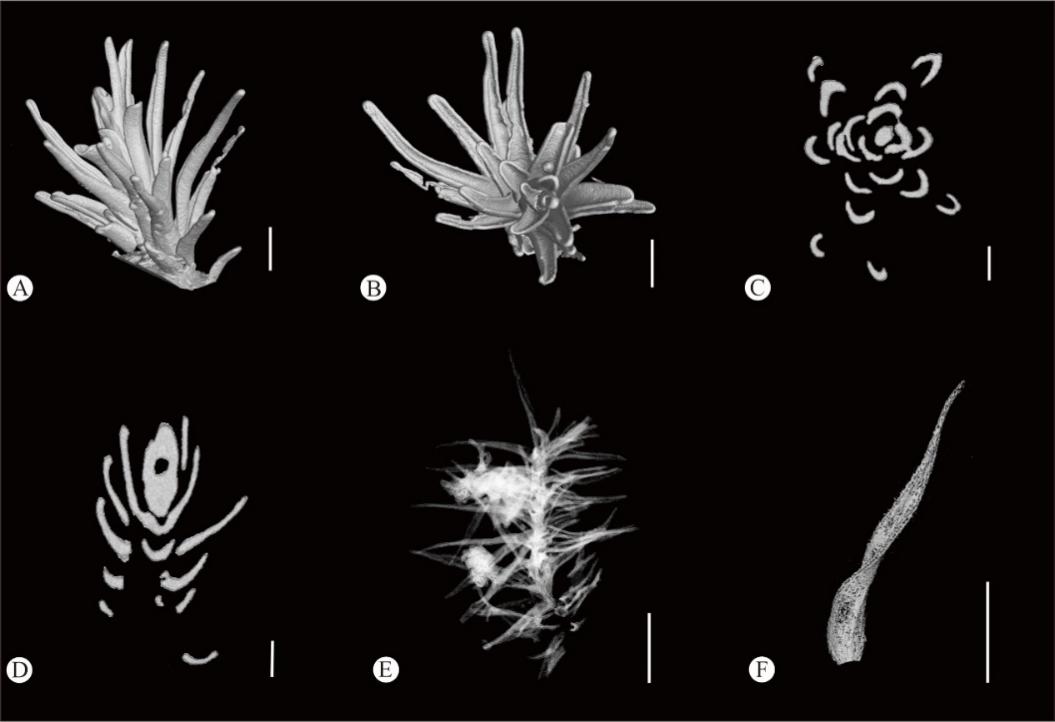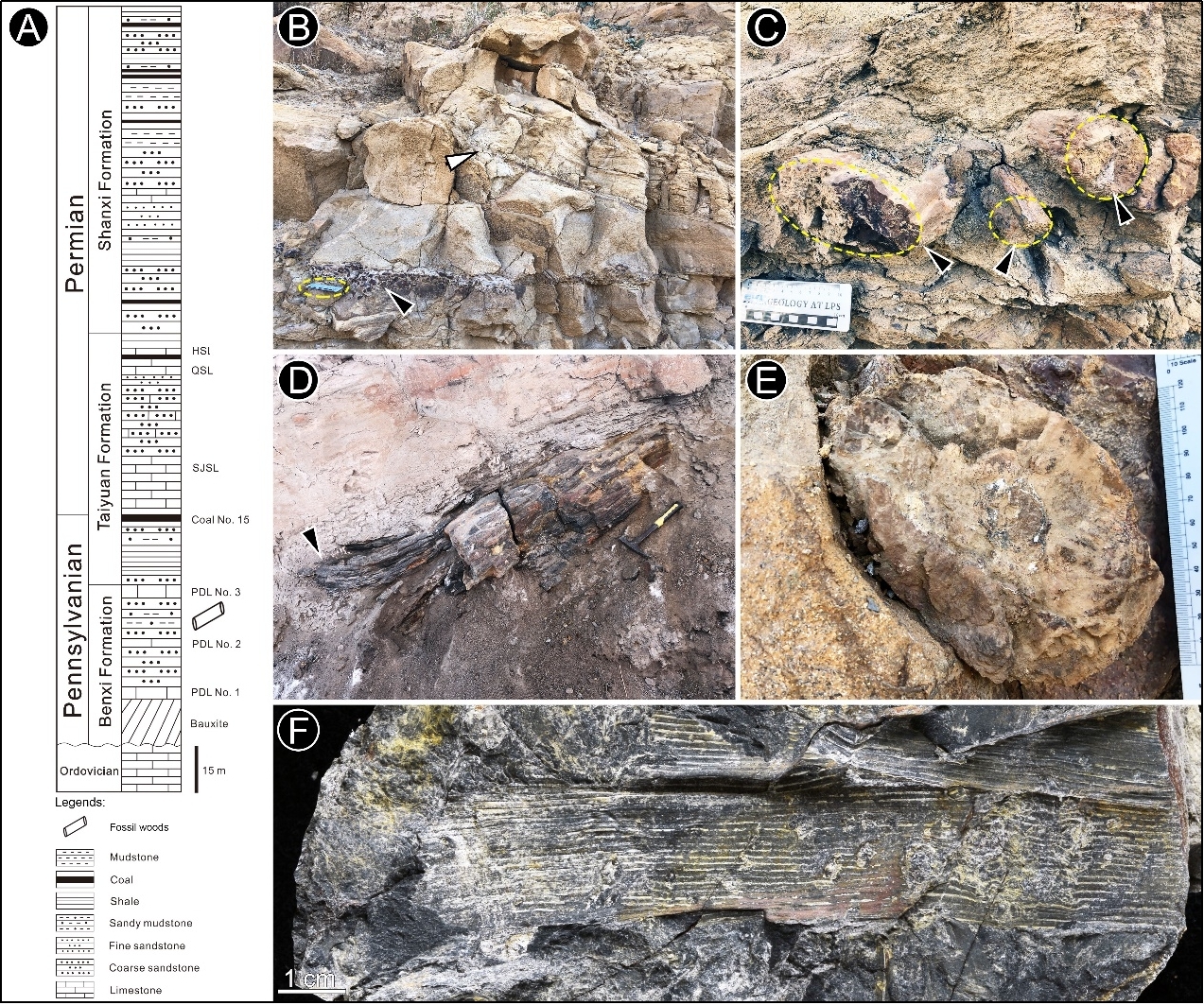科研进展
-
粪化石新材料揭示罗平生物群生态系底层结构组成研究表明,触发中生代海洋生态系统革命的浮游动植物类群(如硅藻,沟鞭藻等)可能是在中生代安尼期之后的某一时段才开始出现并逐渐占据主导。研究已在线发表在国际地学领域专业期刊《古地理,古气候,古生态》(Palaeogeography, Palaeoclimatology, Palaeoecology)。二叠纪-三叠纪之交的大灭绝事件使整个海洋生态系统遭受史无前例的重创,海洋中80%的物种从地球上消失殆尽。崩溃的生态系如何从灭绝的大萧条中逐步复苏,这一科学问题一直是古生物学家和古生态学家关注的焦点。生态系复苏的研究经历了从研究单个属种的多样性变化,到从整个生态系结构的完整度上来衡量复苏的进程及触发机制。现有研究表明,生态系底层的变革,如原始生产者及初级消费者的转变,往往能够对整个生态系产生自下而上的关联性变化,并触发生态系的根本性转变,这尤其以中生代海洋浮游动植物(沟鞭藻,硅藻和颗石藻)的变革进而导致中生代海洋生态系统革命为代表。云南罗平地区中三叠统关岭组中产出的罗平生物群,代表了二叠纪末大灭绝事件后,浅海生态系已完全复苏。该浅海古生态系的建立,也逐步奠定了现代海洋生态系统从雏形到定型的转变。然而,以罗平生物群为代表的浅海生态系,其底层原始生产者及初级消费者的组成特征如何?其结构特征是否是触发罗平生物群古生态系趋于复杂和繁盛的控制因素?这些重要科学问题仍是未解之谜。针对这些科学问题,中国科学院南京地质古生物研究所硕士研究生陈雨萱等人,在罗茂研究员指导下,与成都地质调查中心罗平生物群研究团队、英国布里斯托大学、以及中国科学院海洋研究所的科研人员开展合作研究,在罗平生物群下薄层化石层中发现了一类新的粪化石,为解答这些科学问题,提供了重要线索。相关研究已在线发表在国际地学领域专业期刊《古地理,古气候,古生态》(Palaeogeography, Palaeoclimatology, Palaeoecology)。此次罗平生物群中发现的微体粪化石呈椭球状至短柱状不等,表面光滑,粪化石直径范围在59-247微米。微体粪化石成分为微晶碳酸钙和少量残留有机质,且与疣背糠虾化石伴生。通过CT扫描粪化石内部,发现其具有多对新月形空腔状结构,并伴随有自形黄铁矿晶体。此外,对微体粪化石内部进行连续离子束切割成像中,发现了形态稳定的管状空腔结构,经三维复原,该管状结构形态稳定且直径均一,大小在3-4微米,长度为60微米。这一形态特征与矿化的蓝细菌极为类似。新月形空腔状结构是甲壳动物所产生粪化石的重要识别标志。这一发现限定了此次发现的微体粪化石生产者的搜索范围。此外,本研究还将微体粪化石和与其伴生的疣背糠虾矿化的肠道形态结构及其成分做了详细对比,发现二者在特征上均高度相似。基于以上特征,研究认为此次新发现的微体粪化石为罗平生物群中数量庞大的疣背糠虾这类浮游动物所产生。更为重要的是,粪化石内部保留的管状蓝细菌,很可能表明当时海洋生态系的原始生产者仍为蓝细菌这类比较原始的类群,这与复苏早期,在贵阳生物群中发现的原始生产者相类似。这一结果还表明,触发中生代海洋生态系统革命的浮游动植物类群(如硅藻,沟鞭藻等)可能是在中生代安尼期之后的某一时段才开始出现并逐渐占据主导。该项工作受到国家自然科学基金以及中国科学院人才计划的联合资助。论文相关信息:Chen, Y.X., Luo, Mao., Benton, M.J., Hu, S.X., Zhang, Q.Y., Ji, C., Huang, J.Y., Kou, Q., Zhou, C.Y., Wen, W., 2023. Crustacean microcoprolites from the Middle Triassic Luoping Biota, China: Evidence for primary producers in the first Modern-type marine ecosystems. Palaeogeography, Palaeoclimatology, Palaeoecology, 632, 111840. https://doi.org/10.1016/j.palaeo.2023.111840.罗平生物群中发现的微体粪化石特写罗平生物群中新发现微体粪化石电镜照片及其能谱分析罗平生物群中新发现微体粪化石CT扫描照片显示特征性新月形空腔状构造罗平生物群中新发现微体粪化石离子束切割显示保存完好的管状蓝细菌基于新的粪化石材料恢复的罗平生物群海洋生态系完整结构图,其中蓝细菌和疣背糠虾分别代表了底层原始生产者和初级消费者222023-12
-
祁连山及邻区晚奥陶世三叶虫与原特提斯多岛洋的古地理重建近期,中国科学院南京地质古生物研究所助理研究员魏鑫与团队成员合作,对祁连山及邻区中奥陶世末期-晚奥陶世(达瑞威尔晚期–凯迪期)的三叶虫动物群进行了梳理和统计。研究结果为祁连山及邻区各地体之间的相对位置、原特提斯多岛洋的古地理重建提供了有价值的生物古地理信息。相关研究已在线发表在国际古生物学研究期刊《古生物学论文》(Papers in Palaeontology)。祁连构造带位于我国三大主要板块(华北、华南和塔里木板块)之间,是中亚构造带的重要组成部分。其主体由七个近平行且呈北西-南东走向的构造单元构成,由北向南分别为阿拉善地区、河西走廊地区、北祁连山地区、祁连地体、南祁连山地区、北柴达木地区(欧龙布鲁克地区)和柴达木地体。它们之间常发育奥陶纪的蛇绿岩带,表明祁连山及邻区当时主要为开阔海或弧后盆地环境,属于原特提斯洋的一部分。这也意味着祁连山及邻区虽然现如今拼贴在一起,但在奥陶纪时它们的位置很可能相距甚远。由于祁连山及邻区研究程度相对较低,导致它们在古地理研究中很少被讨论或图示,有时仅合为一个古地理单元(如柴达木-祁连地区)。古生物证据在研究板块和地体的边界位置,以及相对位置时具有重要的作用,而祁连山及邻区的奥陶纪三叶虫十分丰富,因此,这些数据为原特提斯多岛洋(PTAO,Proto-Tethys Archipelagic Ocean)的古地理重建提供了重要信息。近期,中国科学院南京地质古生物研究所助理研究员魏鑫与团队成员合作,对祁连山及邻区中奥陶世末期-晚奥陶世(达瑞威尔晚期–凯迪期)的三叶虫动物群进行了梳理和统计,并结合同时期全球其它地区的三叶虫数据,对37个地区46个层位的299个三叶虫属/亚属进行聚类分析(CA)和非度量性多元标度变换分析(NMDS)。研究结果为祁连山及邻区各地体之间的相对位置、原特提斯多岛洋的古地理重建提供了有价值的生物古地理信息。相关研究已在线发表在国际古生物学研究期刊《古生物学论文》(Papers in Palaeontology)。研究发现,祁连山及邻区的三叶虫动物群表现出与哈萨克地体群、前科迪勒拉地体、Talesh地区、中天山-北山地区、塔里木板块、华北板块、华南板块以及冈瓦纳低纬度地区的古地理联系,这些区域绝大多数被认为是原特提斯多岛洋的一部分。同时,原特提斯多岛洋的三叶虫动物群在古地理上更接近于冈瓦纳低纬度地区,而与劳伦-波罗的-西伯利亚地区以及冈瓦纳中-高纬度地区的三叶虫动物群联系甚少。基于上述动物群的时空分布规律,小多股虫(Pliomerina)和/或中华赛美虫(Sinocybele)分区被定义为该时期原特提斯多岛洋的三叶虫生物地理区系,这一区系主要受低纬度气候带控制并被高纬度的寒流所影响。例如,华南板块及其邻区(如:Tarim,Annamia,Sibuma,East Qinling,Turkestan-Alai,Talesh)可能受赤道冷舌的影响,形成了一个显著的生物地理亚区。此次研究还首次系统地描述了青海门源(北祁连山地区)扣门子组中部(凯迪阶)的三叶虫动物群。该动物群包括三叶虫5科7属7种(新种Remopleurides zhangi),且显示出与同时期哈萨克地体群(如Chu-Ili地体、Chingiz-Tarbagatai地区以及Karatau-Naryn和North-Tien Shan微板块)、华北板块和劳伦板块之间密切的古地理联系。这一结论也与原特提斯多岛洋的古地理格局相一致。该研究得到中国科学院战略性先导科技专项(B类)、国家自然科学基金项目以及现代古生物学和地层学国家重点实验室的联合资助。论文相关信息:Xin Wei, Xiaocong Luan, Yuchen Zhang, Guanzhou Yan, Renbin Zhan. 2023. Katian (Late Ordovician) trilobites of the North Qilian Mountains and their palaeogeographical implications for the Proto-Tethys Archipelagic Ocean. Papers in Palaeontology, e1532. http://doi.org/10.1002/spp2.1532.CA和NMDS均显示出晚奥陶世PTAO与冈瓦纳大陆低纬度地区密切的古地理联系中奥陶世晚期-晚奥陶世早期原特提斯多岛洋的古地理重建中奥陶世晚期-晚奥陶世早期典型的原特提斯多岛洋三叶虫及其时空分布模式青海门源扣门子组中部(凯迪阶)三叶虫新种Remopleurides zhangi sp. nov.212023-12
-
华南板块中奥陶世三叶虫辐射模式及影响因素近期,中国科学院南京地质古生物研究所助理研究员魏鑫等与北京大学地球与空间科学学院、西安地质调查中心的科研人员合作,在高精度生物地层框架下,对华南板块中奥陶世-晚奥陶世早期三叶虫动物群的时空分布规律进行了详细研究。研究通过分析该时期华南板块三叶虫多样性变化和动物群演替的过程,提出了新的辐射模式及其影响因素。奥陶纪生物大辐射是继寒武纪生命大爆发之后又一次海洋生物多样性快速增加事件。三叶虫作为奥陶纪海洋生态系统中主要的生物类群之一,于中奥陶世在全球范围内达到其多样性的峰值。但华南板块的分析显示,其多样性峰值出现在晚奥陶世早期,独特性明显。近期,中国科学院南京地质古生物研究所助理研究员魏鑫等与北京大学地球与空间科学学院、西安地质调查中心的科研人员合作,在高精度生物地层框架下,对华南板块中奥陶世-晚奥陶世早期三叶虫动物群的时空分布规律进行了详细研究。研究通过分析该时期华南板块三叶虫多样性变化和动物群演替的过程,提出了新的辐射模式及其影响因素。相关研究已在线发表在国际地学领域专业期刊《古地理,古气候,古生态》(Palaeogeography, Palaeoclimatology, Palaeoecology)。此次研究统计的最新三叶虫数据和不同分类单元的数量变化结果,揭示了华南板块中奥陶世三叶虫动物群的两次辐射事件,即辐射期(大坪期至达瑞威尔早期)和再辐射期(达瑞威尔末期至桑比早期),两次辐射事件被达瑞威尔中-晚期之初的三叶虫多样性衰落所截断。研究通过Q型聚类分析方法共识别出3个三叶虫类群(即Groups A,B和C),它们分别与华南板块该时期三个宏演化阶段相一致;R型聚类分析则对研究时段进行聚类,揭示了三叶虫动物群的演替过程,且3次动物群演替事件主要以三叶虫生物相的转变为标志,其时间节点和演替过程均与环境变化相耦合。其中,发生在达瑞威尔中-晚期之交的三叶虫动物群演替事件直接引起了早中奥陶世三叶虫动物群向晚奥陶世三叶虫动物群的重大转变,这一事件不仅出现在低纬度地区的华南板块,也出现在中纬度地区的波罗的板块,并以浅水地方分子的大量消亡为特征。白石(Whiterock)三叶虫动物群是古生代演化动物群的重要组成部分,在奥陶纪,白石动物群多样性逐渐增加,并在中晚奥陶世逐步占据各种生态位,被认为是三叶虫在奥陶纪发生辐射的标志。华南板块的白石动物群于中奥陶世大坪晚期-达瑞威尔早期首次在外陆棚环境辐射,随后(达瑞威尔中期)辐射中心迁移至斜坡环境;然而第一次辐射仅仅发生在局部环境中,直到第二次辐射(达瑞威尔末期),白石动物群才在陆棚至斜坡的所有环境中占据优势,逐渐达到辐射顶峰。华南板块中奥陶世三叶虫动物群的两次辐射分别由两次大的海侵事件所触发(大坪晚期-达瑞威尔早期、达瑞威尔晚期-桑比早期),海平面的上升一方面为三叶虫提供了新的生态位,另一方面也加速了不同板块或地体之间动物群的交流。中奥陶世以来,海水氧含量的快速增加也为三叶虫动物群向深水拓展生态位提供了基本条件。此外,全球变凉、底质环境多样化以及区域构造运动也可能促使了三叶虫辐射。该研究得到中国科学院战略性先导科技专项(B类)、国家自然科学基金项目以及现代古生物学和地层学国家重点实验室的联合资助。论文相关信息:Xin Wei, Jianbo Liu, Renbin Zhan, Zhiqiang Zhou, Guanzhou Yan. 2024. Diversity dynamics, faunal turnover and radiation pattern of the Middle Ordovician trilobites in South China. Palaeogeography, Palaeoclimatology, Palaeoecology, 633, 111905. https://doi.org/10.1016/j.palaeo.2023.111905.华南板块中奥陶世-晚奥陶世早期三叶虫宏演化阶段划分暨不同分类单元数量的变化基于Q和R型聚类分析的三叶虫(属)时段分布热图,显示出华南板块中奥陶世-晚奥陶世早期(TS1-9)的三叶虫类群和动物群演替华南板块中奥陶世-晚奥陶世早期三叶虫生物相和岩相沿水深梯度的分布华南板块中奥陶世-晚奥陶世早期三叶虫(属)多样性曲线和相关环境变化202023-12
-
科学家发现已知最古老的蚊子——雄性蚊子曾经也是吸血的12月4日,国际知名期刊《当代生物学》(Current Biology)在线发表了由中国科学院南京地质古生物研究所黎巴嫩籍研究员丹尼·阿扎(Dany Azar)领衔的一项最新研究成果——在距今约1.3亿年前的黎巴嫩琥珀中发现了已知最古老的蚊子化石。这项新发现还证明了在蚊科演化的早期阶段,雄性的蚊子也是吸血的,并揭示昆虫的早期吸血行为比我们想象的更为复杂。12月4日,国际知名期刊《当代生物学》(Current Biology)在线发表了由中国科学院南京地质古生物研究所黎巴嫩籍研究员丹尼 阿扎(Dany Azar)领衔的一项最新研究成果——在距今约1.3亿年前的黎巴嫩琥珀中发现了已知最古老的蚊子化石。这项新发现还证明了在蚊科演化的早期阶段,雄性的蚊子也是吸血的,并揭示昆虫的早期吸血行为比我们想象的更为复杂。蚊子是一种臭名昭著的吸血昆虫,它们吸食人类或动物的血液,并传播疾病。昆虫的吸血行为被认为是从用来取食植物汁液的刺吸式口器转变而来的。例如,吸血跳蚤很可能起源于以花蜜为食的昆虫。但吸血行为的演化过程一直很难研究,部分原因是昆虫化石记录的空白。现今的蚊科具有超过3000种不同类型的蚊子,但人类对它们的起源和早期演化的了解却极为有限。早白垩世的黎巴嫩琥珀保存了已知最古老的琥珀生物群。丹尼 阿扎经过多年艰苦的野外工作,发现并采集了近500处黎巴嫩琥珀产地。此次研究成果来自于其中2块保存了精美蚊子的琥珀。研究人员通过南京古生物所的激光共聚焦显微镜、荧光显微镜等先进科学仪器的仔细观察,发现这两只雄蚊均保存了特有的刺吸式口器:包括呈尖锐三角形的下颚及延长的具有小齿的构造等。现今雌蚊具有刺吸式口器用于吸血,而雄蚊口器退化则多吸食花露。根据此次发现的雄蚊刺吸式口器,研究推测在1.3亿年前雄蚊也是吸血昆虫。虽然分子生物学证据暗示蚊科起源于更古老的侏罗纪,但过去关于蚊科最早的化石记录来自于距今约1亿年前的白垩纪中期。此次发现的琥珀化石中的两只雄性蚊子距今约1.3亿年,将蚊子的化石记录提前了近3000万年。该研究由丹尼 阿扎领衔,法国自然博物馆教授A. Nel,南京古生物所研究员黄迪颖,以及美国自然历史博物馆教授M. Engel等合作完成。研究得到国家自然科学基金委资助。论文相关信息:Dany Azar, Andre Nel, Diying Huang, Michael S. Engel, The earliest fossil mosquito, Current Biology (2023), https://doi.org/10.1016/j.cub.2023.10.047.琥珀中雄蚊背面视图琥珀中雄蚊口器细节图,比例尺:10 m早白垩世黎巴嫩琥珀蚊子化石的生态复原图042023-12
-
白垩纪/古近纪界线海洋和陆地汞记录与德干火山活动研究发现德干玄武岩喷发导致K/Pg界线之前或界线处的汞值呈对数正态分布,与显生宙其他大灭绝事件界线处的汞数据具有相似的趋势。相关研究成果发布在地球科学综合性期刊《地球科学评论》(Earth-Science Reviews)。约6600万年前的白垩纪末生物大灭绝从根本上重塑了地球的生态系统,结束了超过1.5亿年的恐龙时代,并为哺乳动物的崛起铺平了道路。目前,该大灭绝的原因仍处于激烈争论当中,印度徳干玄武岩喷发和小行星撞击是两个主流观点。其中,德干玄武岩喷发对全球古环境、古气候的影响是当前学界研究热点之一。近日,中国科学院南京地质古生物研究所副研究员李莎带领研究团队与中国地质大学(北京)教授万晓樵等合作,对白垩纪/古近纪(K/Pg)界线附近的海相和陆相地层中的汞记录进行了综合对比。研究人员整合了分布于全球各地26个关键剖面和钻孔资料,发现德干玄武岩喷发导致K/Pg界线之前或界线处的汞值呈对数正态分布,与显生宙其他大灭绝事件界线处的汞数据具有相似的趋势。相关研究成果发布在地球科学综合性期刊《地球科学评论》(Earth-Science Reviews)。由于汞同位素可以为追踪汞源提供有效信息,研究人员在胶莱盆地(中国)、松辽盆地(中国)、Meghalaya(德干高原地区)、StevnsKlint(丹麦)和Bottaccione(意大利)剖面和钻孔中,发现奇数汞同位素的非质量分馏信号(Hg-MIF)接近于0,认为其与火山活动从地幔带来的汞有关;在平邑盆地(中国)、Bidart(法国)、Padriciano(意大利)和Bajada del Jag el(阿根廷)的剖面和钻孔中,Hg-MIF偏正,主要代表二价汞沉积,与二价汞的光致还原过程有关;而在Jhilmili(德干高原地区)剖面,Hg-MIF偏负,推测与陆源输入有关。研究结果发现,全球分布的剖面/钻孔的汞记录与徳干火山活动的前两幕相对应:包括第一幕德干玄武岩喷发事件,时间约为66.3至66.15Ma;第二幕德干玄武岩喷发事件,时间约为66.1至66.0 Ma。其中,白垩纪末期变暖事件(LMWE)与第一幕德干玄武岩喷发事件相关,变暖事件对气候变化和生物危机具有全球影响,例如K/Pg界线之前海洋有孔虫的部分灭绝。然而,德干火山活动第三幕(约65.9至65.8Ma)和第四幕(约65.6至65.5 Ma)的汞记录尚未发现。白垩纪末期大灭绝是一场复杂的灾难事件,是由德干火山活动引起的重大气候波动和海洋酸化开始的,并且可能因希克苏鲁伯小行星撞击的影响而加剧。研究结果为我们了解气候变化与生物演化的关系提供了新的证据,也为理解当今全球气候变化对海洋和湖泊环境和生物群的影响提供了参考。此项研究获得了国家自然科学基金委和中国科学院青年创新促进会的资助。论文相关信息:Li, S.*, Grasby, S.E., Xing, Y., Jarzembowski, E.A., Wang, Q., Zhang, H., Wan, X. and Wang, B., 2023. Mercury contents and isotope ratios in marine and terrestrial archives across the Cretaceous/Paleocene boundary. Earth-Science Reviews: 104635. https://doi.org/10.1016/j.earscirev.2023.104635.汞示踪徳干大火成岩省的全球记录徳干玄武岩喷发事件在全球26个海相、陆相地层中记录的汞值(1417个汞数据)呈正态分布的趋势、汞值和部分剖面汞同位素值的范围德干玄武岩喷发汞同位素变化模式图(杨定华绘制)徳干玄武岩喷发事件在全球海相、陆相地层中的汞记录对比302023-11
-
深海珊瑚研究揭示末次冰消期南极冰盖冰下融水释放过程中国科学院南京地质古生物研究所副研究员李涛,与英国布里斯托尔大学、英国圣安德鲁斯大学和南京大学的学者合作,利用南大洋德雷克海峡的深海珊瑚样品,获得了末次冰消期以来高分辨率南大洋中层海水铀同位素演化记录,进而揭示了冰下融水的释放和冰盖退缩、海平面上升之间的直接联系,为预测未来南极冰盖可能的变化提供了重要参考。相关研究成果于2023年11月13日发表在《自然通讯》(Nature Communications)。 地质记录表明南极冰盖在末次冰消期(约1.8-1.1万年前)曾存在几次快速的退缩过程,可能与冰下融水排放导致的冰盖失稳有关。然而,由于缺乏直接的地质证据,冰下融水排放与南极冰盖快速退缩之间的联系尚不清楚。中国科学院南京地质古生物研究所副研究员李涛,与英国布里斯托尔大学、英国圣安德鲁斯大学和南京大学的学者合作,利用南大洋德雷克海峡的深海珊瑚样品,获得了末次冰消期以来高分辨率南大洋中层海水铀同位素演化记录,进而揭示了冰下融水的释放和冰盖退缩、海平面上升之间的直接联系,为预测未来南极冰盖可能的变化提供了重要参考。相关研究成果于2023年11月13日发表在《自然通讯》(Nature Communications)。大陆冰盖底部的水文过程对冰盖的稳定性存在显著的影响,因而受到了广泛的关注。随着压力的增加和温度的升高,冰盖深部的固态冰会逐渐转化为液态融水,在冰盖底部形成许多大小不一的冰下湖泊。现有统计数据表明,全球已探明的冰下湖泊有773个,其中南极洲675个,格陵兰64个。当大陆冰盖不稳定时,冰下湖泊储存的冰川融水可能在数月到数年时间内排干,冰川融水的排放过程也会反过来影响冰盖的稳定性,导致冰架崩塌速度的加快。由于现有观测手段无法直接记录冰盖底部融水的释放过程,因此,目前我们对冰下融水的释放和冰盖退缩之间的联系还缺乏可靠认识。前人研究发现,冰盖底部岩石颗粒表面释放的234U会在冰下融水中不断累积,导致冰下融水通常具有较高的铀同位素值(234U/238U)。最近的研究显示东南极洲底部化学沉积物的铀同位素值可以高达4000‰,如此巨量的过剩234U的释放会显著改变周围海水的铀同位素组成。因此,冰盖附近的海水铀同位素组成是记录冰下融水释放的潜在指标。然而,海水铀同位素的重建需要精确测定样品的绝对年龄和铀同位素组成,大部分地质样品无法满足这一要求。科研人员发现深海珊瑚被证明是记录海水铀同位素组成的可靠载体,从而可以通过铀-钍定年方法获得绝对年龄和初始铀同位素组成。此前就有研究利用深海珊瑚样品重建了末次冰消期以来大西洋和太平洋海水铀同位素演化,揭示了物理风化和水团混合过程对海水铀同位素组成的影响。本研究通过分析南大洋德雷克海峡的深海珊瑚样品,获得了末次冰消期以来高分辨率南大洋海水铀同位素演化记录。数据显示过去1.54万年到1.4万年之间,部分深海珊瑚样品的铀同位素组成存在明显的升高。通过对比不同区域的深海珊瑚铀同位素记录,研究人员排除了其他洋盆的海水和南美洲地表水输入的影响,指出南极冰盖冰下融水释放是导致该时期南大洋海水铀同位素上升的主要原因。该时期南大洋海水铀同位素的异常与冰阀碎屑通量的极高值、融水脉冲事件1A(Meltwater Pulse 1A, MWP-1A)和全球海平面的快速上升具有很好的对应关系,指示了冰下融水释放和冰盖退缩、海平面上升之间的直接联系。同时,通过对比末次冰消期海洋平均温度和南大洋上涌流强度等记录,研究人员进一步指出末次冰消期以来,南极绕极深层水温度的上升和上涌强度的加强可能是导致南极冰盖冰下融水释放和冰盖退缩的先决条件。该研究结果对预测全球变暖背景下南极冰盖底部的水文过程和冰盖稳定性具有重要的指示意义。本研究得到国家自然科学基金重大项目、中国科学院战略性先导科技专项(B类)和中国科学院率先行动人才计划资助。论文相关信息: Li, T.*, Robinson, L.F., MacGilchrist, G.A., Chen, T., Stewart, J.A., Burke, A., Wang, M., Li, G., Chen, J., Rae, J.W.B. Enhanced subglacial discharge from Antarctica during meltwater pulse 1A. Nature Communications 14, 7327 (2023). https://doi.org/10.1038/s41467-023-42974-0.南大洋德雷克海峡深海珊瑚样品分布图末次冰消期深海珊瑚铀同位素记录与其他古气候记录对比图末次冰消期南大洋海水铀同位素演化与冰下融水释放和冰盖演化关系图152023-11
-
早期陆生植物形态学与生物地理学研究新进展近期,中国科学院南京地质古生物研究所早期陆生植物演化研究团队研究员徐洪河、王怿,博士研究生刘炳材、王凯、白姣,联合中国地质大学(武汉)副教授纵瑞文,综合分析了新疆准噶尔盆地志留系普里道利统的植物化石与全区志留纪植物化石记录数据,在早期陆生植物形态学与生物地理学领域取得了新进展。研究成果发表在国际地学领域专业期刊《古地理,古气候,古生态》(Palaeogeography, Palaeoclimatology, Palaeoecology)。植物登陆作为生命演化历程中重要的革新事件之一,深刻影响和改变着地球生态系统。近期,中国科学院南京地质古生物研究所早期陆生植物演化研究团队研究员徐洪河、王怿,博士研究生刘炳材、王凯、白姣,联合中国地质大学(武汉)副教授纵瑞文,综合分析了新疆准噶尔盆地志留系普里道利统的植物化石与全区志留纪植物化石记录数据,在早期陆生植物形态学与生物地理学领域取得了新进展。研究成果发表在国际地学领域专业期刊《古地理,古气候,古生态》(Palaeogeography, Palaeoclimatology, Palaeoecology)。探讨早期陆生植物的散播与生物地理分化是生物宏演化研究的一部分,对深刻理解全球生态系统的演变具有重要意义。通过化石记录与大数据分析有助于深入认识这一主题。最早的陆生植物大化石报道于志留纪温洛克世地层中,随后扩散到全球各大主要陆地块体中。全球志留纪植物大化石主要报道于捷克、英国、澳大利亚和我国华南、新疆等地。新疆准噶尔盆地发育良好的志留纪晚期地层,产有植物化石,为开展早期陆生植物宏演化研究提供了不可替代的化石材料。研究团队基于在新疆准噶尔盆地西缘发现的一种莱尼蕨类植物Aberlemnia junggaria,建立了早期陆生植物形态学测量标准;并使用几何形态测量学方法提取了形态学数据,开展了早期植物定量分析对比。结果表明,新疆发现的Aberlemnia尽管结构简单,却具有显著区别于其他植物的独特特征,比如,其末端枝更为稀疏,且更加狭长。这是形态学测量学在早期陆生植物研究领域的首次应用之一。另外,研究团队还汇总了全球志留纪植物化石产出记录数据,通过聚类,网络等分析手段,重建了志留纪时期植物的时空分布与全球生物地理分区演化。数据分析显示,到志留纪的普里道利时期,陆生植物首次形成明显的地理分区,即,西准噶尔—越南和劳伦—北冈瓦纳两个大植物分区;结合志留纪微体化石记录,陆生植物的分区现象可能早于普里道利期。本研究得到了国家重点研发计划专项和中国科学院科学权威数据库项目支持。本研究是深时数字地球(Deep-time Digital Earth, DDE)国际大科学计划的系列研究成果之一。论文相关信息:Liu B.C., Zong R.W., Wang K., Bai J., Wang Y., Xu H.-H. 2024. Evolution of Silurian phytogeography, with the first report of Aberlemnia (Rhyniopsida) from the Pridoli of West Junggar, Xinjiang, China. Palaeogeography, Palaeoclimatology, Palaeoecology. 633. 111903. https://doi.org/10.1016/j.palaeo.2023.111903.新疆准噶尔盆地西缘普里道利期Aberlemnia junggaria模式标本及早期陆生植物几何形态测量标准早期陆生植物几何形态测量箱线图志留纪微体化石及大化石多样性变化、植物地理分区及时空分布152023-11
-
福建漳浦发现1500万年前琥珀中的苔藓植物。近期,中国科学院南京地质古生物研究所科研人员和中山大学合作,首次利用Micro-CT扫描等实验方法,对我国东南沿海福建漳浦中中新世漳浦生物群中的苔藓植物化石进行系统研究。相关研究成果发表于学术期刊《历史生物学》(Historical Biology)、《古昆虫学》(Palaeoentomology)和《古生物学报》上。苔藓植物作为陆地生态系统的拓荒者之一,是高等植物系统发育中最早分化的一类,并对地质历史时期古生态系统的形成和碳循环具有重要影响。近期,中国科学院南京地质古生物研究所科研人员和中山大学合作,首次利用Micro-CT扫描等实验方法,对我国东南沿海福建漳浦中中新世漳浦生物群中的苔藓植物化石进行系统研究。相关研究成果发表于学术期刊《历史生物学》(Historical Biology)、《古昆虫学》(Palaeoentomology)和《古生物学报》上。苔藓植物化石是研究苔藓植物起源和早期演化的直接证据,更是科研人员探索植物界进化发展、重建古生态和古环境不可缺少的重要组分。我国是苔藓植物种类较多的国家之一,具有全世界苔藓植物种类的十分之一。但苔藓植物化石相对贫乏,目前可靠的化石记录仅有20余种。此次研究植物化石样品中,藓类植物叶片多呈辐射状着生,叶片排列紧密,大多会被邻近生长的叶片遮盖,难以观察其细节特征。南京古生物所副研究员王姿晰等利用Micro-CT扫描等实验方法,清晰观察和研究了藓类植物化石。本研究共鉴定苔藓植物5科5属,包括羽藓科的鹤嘴藓属、牛舌藓科的牛舌藓属、白发藓科的白发藓属、平藓科的扁枝藓属、锦藓科的刺疣藓属。其中牛舌藓属、刺疣藓属、鹤嘴藓属和扁枝藓属化石是东亚地区的首次报道和研究。现生牛舌藓属、刺疣藓属、鹤嘴藓属、白发藓属和扁枝藓属常着生于树干或树枝生长,表明这些化石很可能附生在1500万年前龙脑香科树干或者树枝之上,被树皮上流下的树脂包裹其中,并最终形成了化石。这些苔藓植物化石的发现表明中新世漳浦森林中苔藓植物已经呈现出很高的多样性,是当时森林系统中林下植被的重要组成成分之一。现生白发藓属和鹤嘴藓属主要生长在雨量高、气温高的热带雨林中,植物化石被认为与它们的现生亲缘类群具有相似的生存环境,可印证福建地区在中新世时期比现在更为温暖湿润。近年来,除了苔藓植物之外,漳浦植物群中发现了越来越多的林下植物化石,例如海金沙属、紫萁属和菝葜属等。这些林下植物化石的发现,揭示了福建中新世热带季节雨林具有复杂多层结构的特点。该研究得到了中国科学院战略性先导科技专项(B类)、国家自然科学基金、江苏省青年基金、现代古生物学和地层学国家重点实验室项目等联合资助。化石材料由南京古生物所研究员史恭乐和研究员王博提供。论文相关信息:Zixi Wang*, Ya Li, Xieting Wu, Suxin Yin, Chong Dong, 2023. First fossil record of Pelekium (Thuidiaceae) from the middle Miocene Zhangpu amber in Asia. Historical Biology, online: 1–7. https://doi.org/10.1080/08912963.2023.2176764.Zixi Wang*, Xieting Wu, Suxin Yin, Chong Dong, Weiqiu Liu*, 2023. First fossil record of Trichosteleum (Bryophyta: Sematophyllaceae) from mid-Miocene Zhangpu amber in Asia. Palaeoentomology, 006 (5): 482–495. https://doi.org/10.11646/palaeoentomology.6.5.7.王姿晰*, 刘蔚秋, 李亚, 吴谐婷, 尹素心, 董重, 2023. 福建漳浦中中新世几种藓类植物研究. 古生物学报, 62(2): 309–320. https://doi.org/10.19800/j.cnki.aps.2023001.福建漳浦中新世琥珀包裹体中保存的苔藓植物在显微CT下拍摄的苔藓植物化石图片 鎮ㄤ娇鐢ㄧ殑娴忚鍣ㄤ笉鏀寔鎴栨病鏈夊惎鐢 avascript, 璇峰惎鐢 avascript鍚庡啀璁块棶! [video:福建漳浦中新世琥珀包裹体中白发藓属在显微CT下的三维重建视频]福建漳浦中新世琥珀包裹体中白发藓属在显微CT下的三维重建视频 鎮ㄤ娇鐢ㄧ殑娴忚鍣ㄤ笉鏀寔鎴栨病鏈夊惎鐢 avascript, 璇峰惎鐢 avascript鍚庡啀璁块棶! [video:福建漳浦中新世琥珀包裹体中刺疣藓属在显微CT下的三维重建视频]福建漳浦中新世琥珀包裹体中刺疣藓属在显微CT下的三维重建视频132023-11
-
中国志留系研究一百周年近期,《地层学杂志》(2023年第3期)发表了有关我国志留纪地层对比的两篇论文——《华南东部浙皖苏志留系唐家坞组、康山组和举坑组的时代问题》(戎嘉余等,2023)和《扬子区志留纪晚期地层的时空分布及其地质意义》(王怿等,2023)。论文由中科院南京地质古生物研究所戎嘉余、王怿、唐鹏、张小乐等联合古脊椎动物与古人类研究所盖志琨、赵文金等,以及浙江省地质院汪隆武共同完成。编辑部对论文的主要作者戎嘉余院士和王怿研究员进行了问答式专访,请他们对简要阐述论文撰写前后的思路与后续研究的潜在意义,以飨读者。戎嘉余院士、王怿研究员等在《地层学杂志》发表纪念论文访谈录导言近期,《地层学杂志》(2023年第3期)发表了有关我国志留纪地层对比的两篇论文——《华南东部浙皖苏志留系唐家坞组、康山组和举坑组的时代问题》(戎嘉余等,2023)和《扬子区志留纪晚期地层的时空分布及其地质意义》(王怿等,2023)。论文由中科院南京地质古生物研究所戎嘉余、王怿、唐鹏、张小乐等联合古脊椎动物与古人类研究所盖志琨、赵文金等,以及浙江省地质院汪隆武共同完成。编辑部对论文的主要作者戎嘉余院士和王怿研究员进行了问答式专访,请他们对简要阐述论文撰写前后的思路与后续研究的潜在意义,以飨读者。1. 撰写本文的时机和背景是什么?中国的志留系研究,如果从1924年李四光、赵亚曾发表鄂西的地质记录开始,已过去了整整一个世纪。经过几代地质学者的共同努力,取得了大批成果。扬子区在中国志留系研究中成为标准,实际上既标准也不标准,说标准是中国志留系研究经常以扬子区为基准,说不标准是因为地层发育不全、缺失较多,这种“先天不足”实与“广西运动”密切相关。这是一方面。另一方面,扬子台地龙马溪组及其相当地层之上,常发育两类不同沉积环境,一是广布的正常海域,富含牙形类、几丁虫、三叶虫、腕足类等,以往工作较多且系统;二是非正常(多半淡化)近岸、浅水环境(如浙皖苏区),滋生特殊类群,如鱼类、甲壳动物、遗迹化石、古植物等,以往研究较为欠缺,难为精时对比提供关键证据,对比难度很大。近年来,情况有所变化,各领域学者奋力寻找扬子其他地区重要化石为对比“搭桥”,拿鱼类为例,许多新发现和研究给浙皖苏志留纪地层对比带来了福音。随着全球学者追寻“共同语言”,研究趋向精时化过程,国内开展重点攻关研究(如聚焦Telychian阶),加强与国际接轨。半个世纪以来,扬子区志留系研究浮现出一些亟待解决的问题,其中包括:(1) 扬子多数地区志留系顶界位置不断下压(如纱帽组和韩家店组划归Llandovery统),但苏浙皖志留系划分对比却一直是老大难问题;(2) 扬子区(如宜昌、秀山、石阡、张家界)志留系顶部不断发现Ludlow—Pridoli世地层,但区内时空分布和地质意义有待深入研究。这两个重点对华南地质演变、特别是理解“广西运动”对华南的影响至关重要。在“中国志留系研究”百年之际,我们完成了这两篇有关志留纪地层对比的论文,以表纪念。2. 华南东部志留系研究产生了哪些新认识?哪些化石起了重要作用?四亿多年前,浙皖海域紧靠华夏古陆,热带拥有丰润的雨水并携带大量泥沙沉入海底,滨岸淡化海域滋生了一批特殊生物,但数量稀少,难以发现。另外,对于该区不少岩石地层单位,意见纷繁多变、争议持续不断,如唐家坞组,定义是什么?分布在哪儿?与康山组、举坑组是什么关系?与茅山组是否同期?基于浙皖苏三省区域地质调查大队奋力完成的1/20万地质图报告、区域地层表、地质志和岩石地层及相关成果,我们参考和梳理了108条剖面的岩性特征分析和区域分布,追寻前辈足迹,开展典型剖面的野外考察,新发现多门类化石,建立了化石证据链,再借鉴扬子其他地区岩石地层划分实践,为本区志留系提出了一个新的对比方案。根据化石和海相红层分布特点(图1),我们建议以志留系第一套红层(灰绿色为主夹紫红色碎屑岩)的首现作为识别唐家坞组、康山组和举坑组底界的标志,厘定了各组的含义:(1) 唐家坞组以青灰色碎屑岩占优势,仅下部发育紫红色岩层(系第一套海相红层,分布于浙江淳安、富阳、杭州一带,图2);(2) 康山组为一套巨厚、青灰或黄绿色为主、上下均夹紫红色碎屑岩(浙江安吉、长兴,江苏吴县、无锡等地,系第一套海相红层);(3) 举坑组命名剖面(安徽黄山区)是研究区志留系发育最全的,识别了上(第二套红层,产Llandovery统几丁虫Eisenachitina venusta)、中(不夹紫红色岩层,产秀山动物群特征分子Coronocephalus等)、下(第一套红层,鱼类化石确认其与溶溪组关系密切)三段,分别相当于康山组、坟头组和茅山组。再结合其下伏地层化石,将本区第一套红层置于Aeronian上部至Telychian阶底部(图3)。图1 浙皖苏地区志留系兰多维列统唐家坞组、康山组、举坑组及侯家塘组(含海相红层)的分布图图2 浙江中部志留系兰多维列统唐家坞组的野外露头图3 华南志留系兰多维列统常见门类(如几丁虫、笔石、腕足类、三叶虫、鱼类等)生物地层序列3. 华南志留纪晚期地层的确认有哪些地质意义?如前所述,华南台地内部的志留系,主要发育Llandovery统,其上是否有更新的志留纪地层,国内意见不一。王怿等根据扬子区45条剖面的实地考察和研究,以综合生物地层学为基础,抓住特殊的化石组合,确认小溪组及其相当地层宜划归志留纪晚期,即Ludlow晚期到Pridoli早期,并揭示了它们的时空分布范围。它们与下伏迴星哨组及其相当地层之间为一平行不整合接触。文章着力探讨了这套志留纪晚期地层在认识华南大地构造运动过程中所呈现的意义。该文首次识别出扬子区志留纪晚期地层主要分布区有(图4):(1) 台地内部,它们呈现“分散”的分布特点,实质上是彼此连通的,为近岸、极浅水、非正常(淡化)陆表海,栖息非正常浅海动物与陆生植物;(2) 台地周缘,系盐度正常海域,滋生常见动物类群(如牙形类、几丁虫、腕足类等)。最重要的地质意义在于,证实扬子区志留纪地层发育不全,Llandovery中期到Ludlow世晚期之间约有12百万年的沉积缺失。扬子台地上的志留系,主要有两种发育情况(图5、图6):(1) Telychian中期(还有更早)抬升成陆,Ludlow世晚期又被海水浸漫,接受沉积,但缺失Telychian阶上部、Wenlock统、Ludlow统下部,即“扬子上升”第一幕;到Pridoli晚期海水退出、又遭剥蚀,直至泥盆纪或者更晚,此即“扬子上升”第二幕;(2) 从Telychian中期到泥盆纪晚期或更晚,海水退尽,各地沉积间断呈差异型式,浙皖苏地区与扬子其他地区几乎同步,恰是“扬子上升”在扬子东区的真实反映。由此确认,“扬子上升”是扬子台地古生代地质发展史上规模最大的一次整体性抬升运动,是“广西运动”在扬子台地上的具体体现。图4 扬子区志留纪晚期(Ludlow晚期—Pridoli早期)地层沉积区和推测海域分布区图5 扬子区志留纪晚期地层(Ludlow晚期—Pridoli早期)划分和对比图6 “扬子上升”运动的表现型式及其代表剖面4. 扬子区志留系主要有几套海相红层?研究它有何特殊意义?扬子台地近岸、海相碎屑红层是一套以“紫红色间夹于黄、灰绿色碎屑岩”为特征,是中国志留系的重要组成部分和特色之一,野外易于识别。研究确认:扬子区志留系海相红层主要有三套:(1) 第一套,如溶溪组、举坑组下段,分布最广,紧靠华夏古陆的浙西、浙北最先出现于Aeronian晚期,向西穿时延伸至川中、川北滞后出现于Telychian早期;(2) 第二套, 如迴星哨组、西坑组、举坑组上段,时代为Telychian中期,在华南东部只见于黄山区,尚未在该区以西查实;(3) 第三套,如小溪组、车家坝组、关底组,时代为Ludlow晚期至Pridoli早期,尚未在浙江和安徽东南部发现。新疆、甘肃、青海和西藏等地也发育志留系海相红层,相关研究正在深入。晚奥陶世扬子、华夏两大块体强烈相向运动,导致江南区与下扬子区彻底融为一体。华夏块体自东向西推移挤压,使浙皖海盆强烈沉降和快速堆积,在氧化、淡化、临滨三角洲海域,沉积了特征鲜明的志留系海相红层。这些不同时代海相红层的识别有助于国内外志留纪地层对比,有助于扬子海域沉积环境、古地理和古气候及古海洋氧化还原系统演变的深入研讨。深化海相碎屑红层的综合研究,对于探索扬子海域氧化事件的幕式发展有重要意义。5. 为什么选择在《地层学杂志》发表?地层学是地球科学中一门奠基性的学科,是地质基础工作的基础。《地层学杂志》是专门报道地层学及其相关地质学、沉积学、古地理学等研究进展的一流专业学术期刊,面向国内科研院所和一线地质工作者,在基础地质研究领域具有广泛影响;在适应国家重大战略需求、推动国内地层学发展和与国际接轨方面均需有所展现。这两篇论文讨论了扬子区(含华东地区)志留纪地层时代、划分和对比,属于阶段性的基础研究成果。在《地层学杂志》发表有助于加快国内志留系研究进程、加强和推进与相关专业学者的沟通与交流。尾声论文作者告诉《地层学杂志》编辑部:这两篇论文是中国志留系研究向国际标准精时化过程中深化对比的阶段性成果,体现了中科院所所联合和与地方地调院合作,也是南京地质古生物所早古生代团队长期研究的集成;华南志留系划分对比研究仍有许多争论,文中提出的新认识尚待同行和笔者自己证伪,更多的化石等待发现;沉积、古生态、古气候、古地理、同位素地质年代等工作有待强化和深化。感谢国家重点研发计划项目和国家自然科学基金委项目对华南志留系研究的支持。文章信息:戎嘉余, 王怿, 唐鹏, 张小乐, 盖志琨, 魏鑫, 詹仁斌, 汪隆武, 燕夔, 黄冰, 山显任, 闫冠州, 林翔鸿. 2023. 华南东部浙皖苏志留系唐家坞组、康山组和举坑组的时代问题. 地层学杂志, 47(3): 237-267. https://doi.org/10. 19839/j.cnki.dcxzz.2023.0015.王怿, 戎嘉余, 唐鹏, 张小乐, 赵文金. 2023. 扬子区志留纪晚期地层的时空分布及其地质意义. 地层学杂志, 47(3): 268-284. https://doi.org/10.19839/j.cnki.dcxzz.2023.0016.下载途径:《地层学杂志》官网(https://dcxz.cbpt.cnki.net),点击论文题目下方的“下载”。102023-11
-
矿化植物研究揭示我国华北板块晚石炭世复杂陆地生态系统近期,中国科学院南京地质古生物研究所博士研究生王柯寓,在副研究员万明礼的指导下,与助理研究员黄兴、研究员王军,以及美国密苏里科技大学的研究团队合作,对产自我国山西省阳泉市本溪组的矿化植物标本开展了深入的系统分类学和古生态学研究。相关研究成果发表于国际学术期刊《古植物学与孢粉学论评》(Review of Palaeobotany and Palynology)和《远古世界》(Palaeoworld)上。华北克拉通是中国大陆的主要构造单元之一,其在中元古代至古生代进入稳定发展阶段;中奥陶世至晚石炭世早期时,华北克拉通经历了整体抬升的构造运动,因此造成了上奥陶统至上石炭统下部的缺失,其间普遍形成平行不整合。由于在晚石炭世莫斯科期开始才接受沉积,因此该时期本溪组中产出的植物化石代表了华北克拉通上最古老的陆生维管植物。自上个世纪三十年代开始,国内、外专家学者对我国华北的晚石炭世植物群开展了一系列的研究。受限于化石保存状况不佳和研究程度不够深入,对我国晚石炭世植物的系统分类学研究在本世纪初陷入停滞。近期,中国科学院南京地质古生物研究所博士研究生王柯寓,在副研究员万明礼的指导下,与助理研究员黄兴、研究员王军,以及美国密苏里科技大学的研究团队合作,对产自我国山西省阳泉市本溪组的矿化植物标本开展了深入的系统分类学和古生态学研究。相关研究成果发表于国际学术期刊《古植物学与孢粉学论评》(Review of Palaeobotany and Palynology)和《远古世界》(Palaeoworld)上。通过对60余株矿化木材进行解剖学研究,科研人员首次报道了我国晚石炭世时期乔木型科达类植物Damudoxylon meii Wang et Wan sp. nov.,和Agathoxylon leei (Sze) Wang et Wan comb. nov.,以及早期松柏类(广义)植物Parnaiboxylon wangi Wang et al. sp. nov.等。根据植物异速生长经验公式计算得知,晚石炭世时期的华夏植物区科达类植物生长高度可达30米,纠正了欧美古植物学者关于我国晚石炭世本溪组沉积时期没有高层植被的错误观点。结合沉积学等的证据表明,高大的乔木型科达类植物生活于河流滨岸环境下,并扮演了重要的冠层植被角色。此外,化石木材中还保存了数量可观、结构精美的化石真菌,以及大量的粪便化石。根据粪便化石的大小、形态、表面结构等特征的分析,推测这些粪便是由甲螨取食木材遗体过程中留下的。“哺育木”(nurse log)是指植物的茎干或树桩在死亡和腐烂之后,为其他植物的种子萌发以及幼苗生长提供营养和水分,是现代森林群落生态系统中重要的组成部分,可保障群落的稳定性和持续发展。尽管“哺育木”是现代森林系统重要的生态现象之一,由于缺乏化石证据,其起源与演化人们了解的并不多。本次研究的化石木材中发现了科达类植物的茎干中穿插了大量的裸子植物的“小根”,是迄今为止最古老的“哺育木”现象,表明在3.1亿多年前的华夏植物群中已经出现了当代森林生态系统中植物—植物相互作用的生态现象。结合前人研究成果与本研究的最新发现,在华夏植物群演化的早期阶段,植物多样性、特别是裸子植物的多样性远高于过去的认知,矿化植物的研究能够在很大程度上弥补印痕化石保存受沉积环境影响的不足。更重要的是,植物—节肢动物、植物—真菌,以及植物—植物等相互作用的生态现象在晚石炭世时期的华夏植物地理区已经十分普遍,表明当时的陆地生态系统结构已经十分复杂。本研究得到了国家重点研发计划、国家自然科学基金委、中国科学院青年创新促进会以及现代古生物学和地层学国家重点实验室的资助。研究也得到阳泉市自然资源局的野外支持。论文相关信息:Wang K., Huang, X., Yang W., Wang J., Wan M.*, 2023. A new gymnospermous stem from the Moscovian (Carboniferous) of North China, and its palaeoecological significance for the Cathaysian Flora at the early evolutionary stage. Review of Palaeobotany and Palynology, 311, 104858. https://doi.org/10.1016/j.revpalbo.2023.104858.Wang K., Huang, X., Yang W., Wang J., Wan M.*, 2023. First record of plant-plant facilitative interaction from the Moscovian (Pennsylvanian, upper Carboniferous) of North China. Palaeoworld. https://doi.org/10.1016/j.palwor.2023.08.002.Wang K., Yang W., Li D., Wang J., Wan M.*, 2022. Anatomically preserved cordaitalean trees from the Pennsylvanian of Yangquan City, Shanxi Province, and their implication for a perhumid climate in North China Block. Palaeoworld, 31, 294–310. https://doi.org/10.1016/j.palwor.2021.07.004.图1 剖面图及矿化木材野外分布图图2 Parnaiboxylon wangi Wang et al. sp. nov.解剖图及其中的真菌菌丝和甲螨粪便图3 Agathoxylon leei (Sze) Wang et Wan comb. nov.及生活在其上的裸子植物小根(哺育木)072023-11

